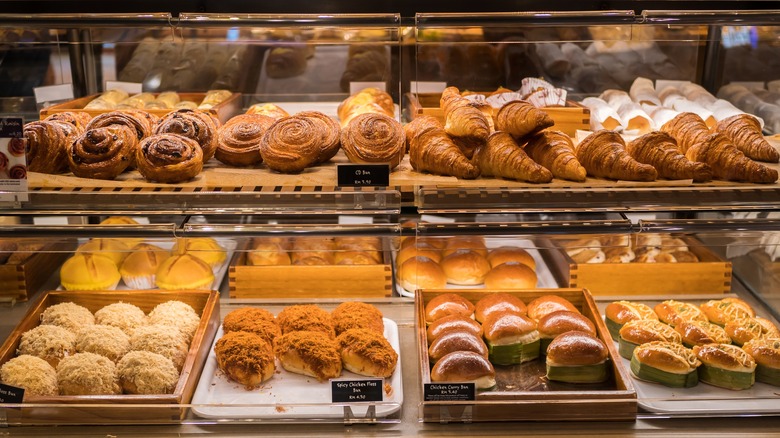The Origin Of Bakeries Goes Way, Way Back
There's just something subtly magical about stepping into a bakery. Smelling freshly baked bread, spotting a dazzling display of colorful pastries, and checking out all the intricately designed cakes can make us feel like kids in a candy store. If the "Great British Baking Show" has taught us anything, it's that the art of baking is a precise one that requires patience and skill. Every layer, drizzle, filling, and flavor is crafted as a labor of love, which is probably why a bakery's atmosphere is so cozy and inviting. They've been around for thousands of years, filling bellies and putting smiles on people's faces as far back as ancient Rome.
We have Pliny the Elder to thank for detailing the spread of commercialized bakeries across Rome around 168 B.C. During this time, bread making had evolved from your basic household prep, and the work was turned over to "guilds" where enthusiastic bakers shared knowledge, tips, and new ideas with one another. Soon after, the modern-day equivalent of food stalls began surfacing everywhere, where locals could grab what bread they needed. Pliny even records that there were several different types of bread in existence, and that white bread was the more popular choice compared to darker varieties.
Bread was an important part of Roman communities, and was typically enjoyed as a special treat for celebrations, weddings, or other festive events. As artisans continued to perfect their craft, concoct new bread recipes, and as technology gradually advanced, bread got even fancier.
Specific bread was reserved for the Roman elite
While sourdough bread was among one of the most popular types during the age of the Roman Empire, the baker's guilds were always cooking up unique flavor pairings and textures to test. The available bread varieties would depend on a citizen's class and the area where they lived. If you were poor and lived in a rural area, you'd likely receive hard bread made with low-quality flour with a mixture of legumes and tree nuts. Expensive, soft bread was a luxury, and it was made with ingredients like milk, honey, wine, and sometimes candied fruit. Now we do as the Romans do, except better. There are dozens of delicious kinds of bread made all over the world, complete with a seemingly endless list of flavors that's always growing.
One of the largest tombs in Rome, that of Eurysace the Baker, has a sprawling relief mural that depicts people making bread, and each step along the way. There isn't too much physical evidence of the world's earliest bakeries, apart from written text, although, outside of Rome in places like Pompeii, multiple bakeries have been found from this era, even fossilized bread preserved in ovens.
Even though bread was enjoyed centuries before bakeries became a thing, Ancient Rome gave bread its own special place in the world. To this day, the art of bread making is a beautiful tradition that merges both ancient and newer techniques, and the bread never stops getting better.

